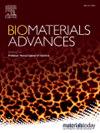Multifunctional bioactive metal phenolic networks (MPN) with copper ion retardation and dual-peptides for enhanced osteointegration
IF 5.5
2区 医学
Q2 MATERIALS SCIENCE, BIOMATERIALS
Materials Science & Engineering C-Materials for Biological Applications
Pub Date : 2025-06-14
DOI:10.1016/j.bioadv.2025.214388
引用次数: 0
Abstract
Titanium rods are widely used as orthopedic implants, but their biologically inert surface limits their effectiveness in bone healing. To enhance osseointegration, implants need to be multifunctional, capable of modulating cellular behaviors such as early adhesion, migration, angiogenesis, and bone formation. In this study, copper ion-doped phenolic networks (P/Cu MPNs) were developed as a platform for grafting bioactive peptides (OGP and RGD), terminally coupled with K6 (hexameric lysine), to create a multifunctional bioactive coating (RGD/OGP@P/Cu) aimed at improving osteointegration. The properties of RGD/OGP@P/Cu, including hydrophilicity, chemical composition, morphology, roughness, and mechanical characteristics, were thoroughly characterized using techniques such as XPS, AFM, and SEM. The peptide coating effectively modulates the release of copper ions, and the synergistic effects of copper ions and bioactive peptides promoted cell adhesion, migration, osteogenesis, and angiogenesis in vitro. Furthermore, in a rat bone defect model, RGD/OGP@P/Cu demonstrated promising potential for bone regeneration and osseointegration. This synergistic strategy between peptide and controlled release of metal ions has great potential for application in promoting implant osseointegration in complex biological environments.
多功能生物活性金属酚网络(MPN)与铜离子阻滞和双肽增强骨整合
钛棒被广泛用于骨科植入物,但其生物惰性表面限制了其骨愈合的有效性。为了增强骨整合,种植体需要是多功能的,能够调节细胞行为,如早期粘附、迁移、血管生成和骨形成。在这项研究中,铜离子掺杂的酚网络(P/Cu MPNs)被开发为接枝生物活性肽(OGP和RGD)的平台,末端与K6(六聚赖氨酸)偶联,以创建旨在改善骨整合的多功能生物活性涂层(RGD/OGP@P/Cu)。利用XPS、AFM和SEM等技术对RGD/OGP@P/Cu的亲水性、化学组成、形貌、粗糙度和力学性能进行了全面表征。肽包被可有效调节铜离子的释放,铜离子与生物活性肽的协同作用可促进体外细胞粘附、迁移、成骨和血管生成。此外,在大鼠骨缺损模型中,RGD/OGP@P/Cu显示出良好的骨再生和骨整合潜力。这种肽与金属离子调控释放的协同策略在复杂生物环境下促进种植体骨整合方面具有很大的应用潜力。
本文章由计算机程序翻译,如有差异,请以英文原文为准。
求助全文
约1分钟内获得全文
求助全文
来源期刊
CiteScore
17.80
自引率
0.00%
发文量
501
审稿时长
27 days
期刊介绍:
Biomaterials Advances, previously known as Materials Science and Engineering: C-Materials for Biological Applications (P-ISSN: 0928-4931, E-ISSN: 1873-0191). Includes topics at the interface of the biomedical sciences and materials engineering. These topics include:
• Bioinspired and biomimetic materials for medical applications
• Materials of biological origin for medical applications
• Materials for "active" medical applications
• Self-assembling and self-healing materials for medical applications
• "Smart" (i.e., stimulus-response) materials for medical applications
• Ceramic, metallic, polymeric, and composite materials for medical applications
• Materials for in vivo sensing
• Materials for in vivo imaging
• Materials for delivery of pharmacologic agents and vaccines
• Novel approaches for characterizing and modeling materials for medical applications
Manuscripts on biological topics without a materials science component, or manuscripts on materials science without biological applications, will not be considered for publication in Materials Science and Engineering C. New submissions are first assessed for language, scope and originality (plagiarism check) and can be desk rejected before review if they need English language improvements, are out of scope or present excessive duplication with published sources.
Biomaterials Advances sits within Elsevier''s biomaterials science portfolio alongside Biomaterials, Materials Today Bio and Biomaterials and Biosystems. As part of the broader Materials Today family, Biomaterials Advances offers authors rigorous peer review, rapid decisions, and high visibility. We look forward to receiving your submissions!

 求助内容:
求助内容: 应助结果提醒方式:
应助结果提醒方式:


